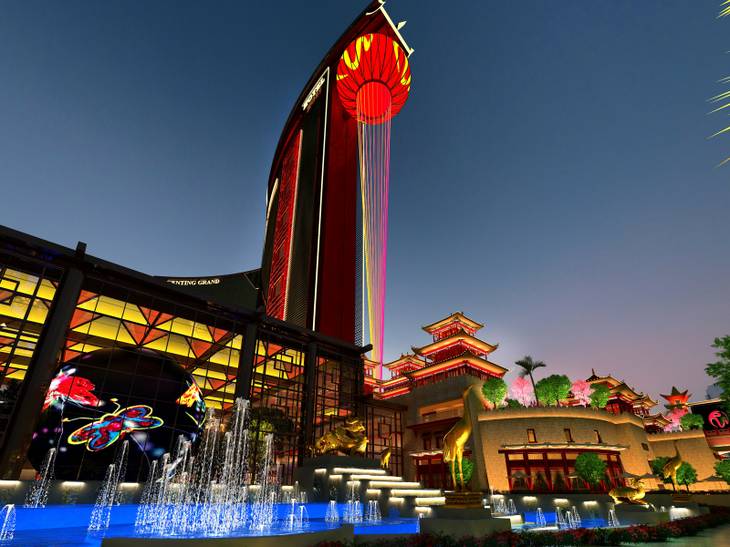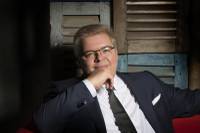Resorts World Las Vegas isn’t necessarily trying to one-up other properties on the Strip. It just wants to be distinct.
K.T. Lim, chairman and CEO of developer Genting Group, is interested in growing the entire local tourism market, not vying for someone else’s share of the pie, said Las Vegas architect Paul Steelman, who is behind Resorts World’s design.
“He wants to expand the Las Vegas market rather than doing something better than someone else,” Steelman said.
Steelman’s architectural vision will be key to making that happen. Construction on Genting’s $4 billion, Chinese-themed resort began May 5 on the site formerly home to the Stardust, then Boyd Gaming’s scrapped Echelon project. Work is expected to be completed in multiple phases, with the first opening to the public in 2018.
Steelman has played an integral role in the project since its inception. He sat down with VEGAS INC to discuss plans for Resorts World, its panda habitat, its place in Las Vegas architectural history and more.
What made the former Echelon site so appealing?
I’m speaking a little bit for Lim; obviously, he made the ultimate choice. But I think there were a couple of things.
No. 1, we thought we could work within the existing Echelon master plan design of the towers and garages and so on. Buildings take some time to construct, and of course, time is money in our gaming business. A building that takes a year less to construct is a more financially secure building than one that is strung out through the construction.
No. 2, the site was big: 83 or 84 acres. If you look at Genting’s properties now, the most successful properties the company runs in Malaysia and Singapore, both of those have very large footprints.
So when it came right down to it, it was a good price, it was a good asset, it was a large piece of property, and of course, it was on Las Vegas Boulevard. So it had all the makings of what Genting would like to see in a resort.
What are some of the challenges incorporating the existing Echelon frame into the design of Resorts World?
Times have changed a little bit from when Echelon was originally designed and started construction. We have to say, “Is what was on the Echelon plan suitable for today?” And how has gaming or how has the Las Vegas market or how has the overall approach, the integrated resort, changed what we should do?
The major elements stay the same, the tower footprint stays the same. Of course, there are new elevators being added, new entrances, new porte-cocheres, new division of hotels, new ways to operate the hotel, different service elevator configurations — all sorts of things to make the hotel run more like a Genting hotel. We have all the master-plan elements there to build the building as we see fit, and then we have to redesign the building to accomplish these goals.
Architecturally, have the plans changed substantively since the rough sketch was revealed in 2013?
All plans do. The basic idea is still the same, the basic master plan is still the same, but the actual offerings are somewhat different.
Our designs work on a series of emotions. There’s basically three. We work on a “wow” in the lobby. We want that to be one of your memories of your life, so it gets posted on Facebook and Twittered around. It becomes a social media phenomenon. Then, when we get in the casino: You can win. You’re James Bond! Power is the emotion to win in the casino. And then we want to give you someplace to relax. And where do we do that? In the restaurants.
What are some of the “wow” amenities? Everyone talks about the Great Wall of China replica and the panda habitat.
The panda habitat is going to be moved to phase two, as will the water park.
There are, of course, many other attractions, starting with our ball that drops on the outside of the building, the Chinese village, the Great Wall and all the integration of that with the Strip.
Our goal in anything we design is actually very simple: We want to make you smile. If we get somebody with a simple smile, they’re going to come back.
What will set Resorts World apart from everything else on the Strip, particularly the newest wave of resorts?
Las Vegas is a fantasy type of place — a little bit like Disney. We went off the rails a little bit when we started to say, “Well, we could do something citylike, some modern architecture,” and the modern architecture would in fact resonate with the casino customers. Now, modern architecture does resonate with a lot of people. But Las Vegas is a fun-in-the-sun vacation spot. And tall, high-rise glass- and steel-laden buildings that are similar to many cities in the United States, face it: They do not give you the impression of a vacation spot. They might give you the impression of a great building, don’t get me wrong. I’m a modern architect; I love modern architecture. But if you ask the normal person walking down the street do they know what that modern architecture is, do they know what it’s about, in most cases, they don’t. These super modern buildings that had a statement were good-looking buildings, were dynamic, but they didn’t feel like they were attacking the three emotions we want to design with.
At the end of the day, it’s a fine combination of modern architecture and getting the feeling across, but the feeling can’t come across so themed that it starts to look like some of the old themed-type places here that we used to have. Even when we did the Mirage in 1989, you could see that we didn’t put any of that Hawaiian stuff into the tower. We said, “Ah, the tower’s got to resonate as its own independent building.”
Is this the beginning of a new phase of architecture and development on the Strip or a resurgence of that themed era?
I definitely feel it is an expansion of the market, and I definitely feel it’s a new phase. No doubt.
What is that new phase, then?
That new phase is going to be more attraction-based. I think attraction-based tourism is going be greater, and I think the attractions will be diversified.
Who is your target audience? Who is Resorts World Las Vegas designed to appeal to?
I don’t think it’s any different than all of Genting’s projects. All of their projects have a larger appeal base than most. They appeal, in Malaysia and Singapore, to a diverse range of families, young couples, middle-income visitors. Yet at those integrated resorts, they also appeal to a large group of VIPs who love the attractions.

